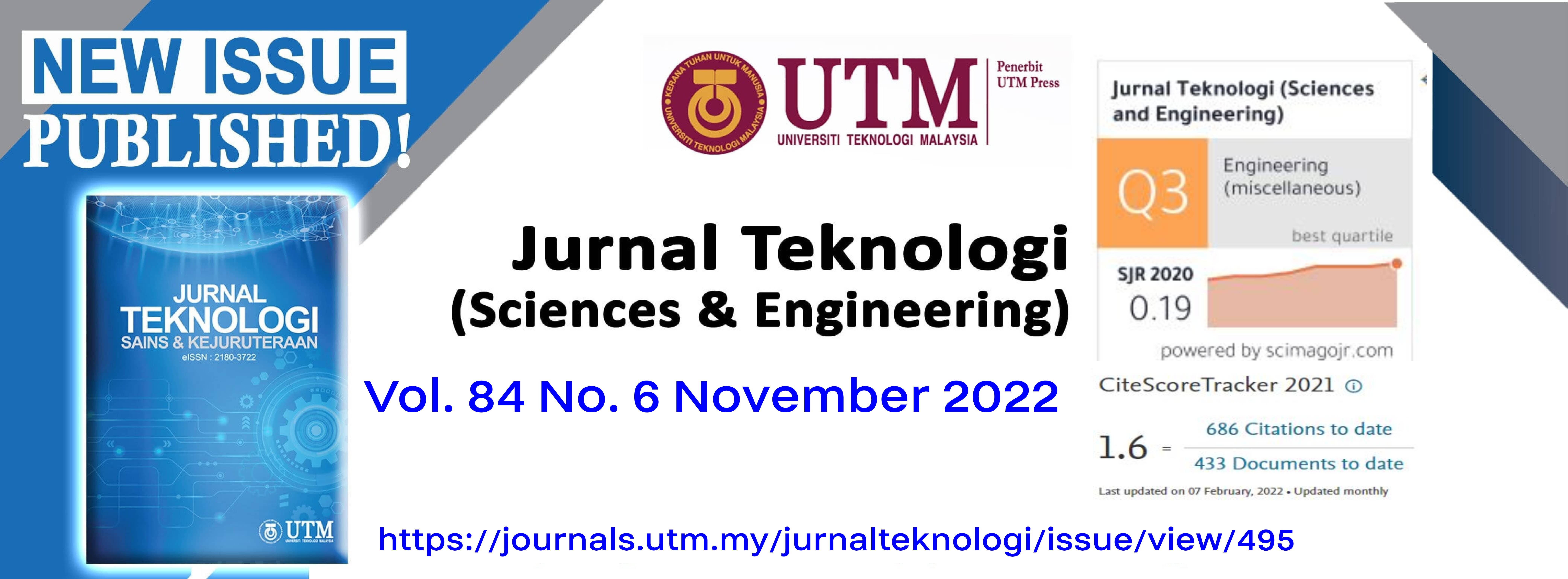APPLICATION OF TAGUCHI METHOD TO OPTIMIZE FUSED DEPOSITION MODELING PROCESS PARAMETERS FOR SURFACE ROUGHNESS
DOI:
https://doi.org/10.11113/jurnalteknologi.v84.18430Keywords:
Process parameters optimization, surface roughness, fused deposition modeling, Taguchi method, s/n ratioAbstract
Surface quality is one of the limiting aspects of additive manufacturing (AM). This paper presents the findings from a study to optimize Fused Deposition Modeling (FDM) process parameters to improve the surface roughness of the printed test specimen. Taguchi 3⁴ and L9 orthogonal array were used to design the experiment. Samples models of the same size were fabricated with an open source FDM printer using acrylonitrile butadiene styrene (ABS) material and were examined to see the structural differences. Taguchi method S/N ratio and means analysis was used to find the optimum process parameter for surface roughness. The results indicate that flow rate is the most influential process parameter towards better surface roughness, followed by layer height, printing temperature and print speed. The surface roughness of printed test specimen was found to be rougher with the increase in levels of flow rate. The flow rate is responsible for the unevenly aligned section of the deposited filament. It was discovered that the optimal proses parameter levels for surface roughness by the CR-10S Pro FDM machine are 0.1 mm of layer height, 90% of flow rate, 230°C of printing temperature, and 35mm/s of print speed. Thus, Taguchi method has proven to be a useful approach for optimizing parameters to improve the surface roughness of printed parts.
References
ISO/ASTM. 2013. Additive Manufacturing - General Principles Terminology (ASTM52900). Rapid Manufacturing Association. 10-12.
Chen, L., X., Zhang, & S. Gan. 2020. Effects of Laser Polishing on Surface Quality and Mechanical Properties of PLA Parts Built by Fused Deposition Modeling. Journal of Applied Polymer Science. 137(3): 48288.
Mohamed, O. A., Masood, S. H., & Bhowmik, J. L. 2015. Optimization of Fused Deposition Modeling Process Parameters: A Review of Current Research and Future Prospects. Advances in Manufacturing. 3(1): 42-53.
Alsoufi, M. S., & A. E. Elsayed. 2018. Surface Roughness Quality and Dimensional Accuracy-A Comprehensive Analysis of 100% Infill Printed Parts Fabricated by a Personal/Desktop Cost-Effective FDM 3D Printer. Materials Sciences and Applications. 09(01): 11-40.
Shubham, P., C., Aggarwal, & S. Joshi. 2018. Optimization of Process Parameter to Improve Dynamic Mechanical Properties of 3D Printed ABS Polymer using Taguchi Method. International Journal of Mechanical and Production Engineering. 6: 2321-2071.
Radhwan, H., Z., Shayfull, S. M., Nasir, A. E. H., Abdellah, & A. R. Irfan. 2020. Optimization Parameter Effects on the Quality Surface Finish of 3D-Printing Process using Taguchi Method. IOP Conference Series: Materials Science and Engineering. 864(1).
Basavaraj, C. K., & M. Vishwas. 2016. Studies on Effect of Fused Deposition Modeling Process Parameters on Ultimate Tensile Strength and Dimensional Accuracy of Nylon. IOP Conference Series: Materials Science and Engineering. 149(1).
Sammaiah, P., Rushmamanisha, K., Praveenadevi, N., & Reddy, I. R. 2020. The Influence of Process Parameters on the Surface Roughness of the 3D Printed Part in FDM process. IOP Conference Series: Materials Science and Engineering. IOP Publishing. 981(4): 042021.
Ahmad, M. N., M. H., Ab Rahman, N. A., Maidin, M. H., Osman, M. K., Wahid, H., Mohamed Saiful Firdaus, & N. A. Abd Aziz. 2020. Optimization on Surface Roughness of Fused Deposition Modeling 3D Printed Parts using Taguchi Approach. Lecture Notes in Mechanical Engineering. July: 230-243.
Aslani, K. E., D., Chaidas, J., Kechagias, P., Kyratsis, & K. Salonitis. 2020. Quality Performance Evaluation of Thinwalled PLA 3D Printed Parts using the Taguchi Method and Grey Relational Analysis. Journal of Manufacturing and Materials Processing. 4(2).
Sajan, N., T. D., John, M., Sivadasan, & N. K. Singh. 2018. An Investigation on Circularity Error of Components Processed on Fused Deposition Modeling (FDM). Materials Today: Proceedings. 5(1): 1327-1334.
Rane, K., & M. Strano. 2019. A Comprehensive Review of Extrusion-based Additive Manufacturing Processes for Rapid Production of Metallic and Ceramic Parts. Advances in Manufacturing. 7(2): 155-173.
Prakash, K. S., T., Nancharaih, & V. V. S. Rao. 2018. Additive Manufacturing Techniques in Manufacturing - An Overview. Materials Today: Proceedings. 5(2): 3873-3882.
Manikandan, S., A. S. S., Kumar, & C. Sharma. 2015. Investigation on the Effect of Fused Deposition Modeling Process Parameters on Flexural and Surface Roughness Properties of PC-ABS Blend. International Journal on Recent Technologies in Mechanical and Electrical Engineering (IJRMEE). 2(8): 41-47.
Jin, Y.A., H., Li, Y., He, & J. Z. Fu. 2015. Quantitative Analysis of Surface Profile in Fused Deposition Modeling. Additive Manufacturing. 8: 142-148.
Barrios, J. M., & P. E. Romero. 2019. Improvement of Surface Roughness and Hydrophobicity in PETG Parts Manufactured via Fused Deposition Modeling: An Application in 3D printed self-cleaning parts. Materials. 12(15).
Raffic, N. M., K. G., Babu, & P. Madhan. 2019. Application of Taguchi's Experimental Design and Range Analysis in Optimization of FDM Printing Parameters for PET-G, PLA and HIPS. International Journal of Scientific and Technology Research. 8(9): 891-902.
Sukindar, N. A., M. K. A. M., Ariffin, B. T. H. T., Baharudin, C. N. A.,Jaafar, & M. I. S. Ismail. 2017. Optimization of the Parameters for Surface Quality of the Open-source 3D Printing. Journal of Mechanical Engineering. SI 3(1): 33-43.
Altan, M., M., Eryildiz, B., Gumus, & Y. Kahraman. 2018. Effects of Process Parameters on the Quality of PLA Products Fabricated by Fused Deposition Modeling: Surface Roughness and Tensile Strength. Materials Testing. 60(5): 471-477.
Akande, S. O. 2015. Dimensional Accuracy and Surface Finish Optimization of Fused Deposition Modeling Parts using Desirability Function Analysis. Int. J. Eng. Res. Technol. 4(4): 196-202.
Maidin, S., Wong, J. H. U., Mohamed, A. S., & Mohamed, S. B. 2017. Effect of Vacuum Assisted Fused Deposition Modeling on 3D Printed ABS Microstructure. International Journal of Applied Engineering Research. 12(15): 4877-4881.
Downloads
Published
Issue
Section
License
Copyright of articles that appear in Jurnal Teknologi belongs exclusively to Penerbit Universiti Teknologi Malaysia (Penerbit UTM Press). This copyright covers the rights to reproduce the article, including reprints, electronic reproductions, or any other reproductions of similar nature.
















